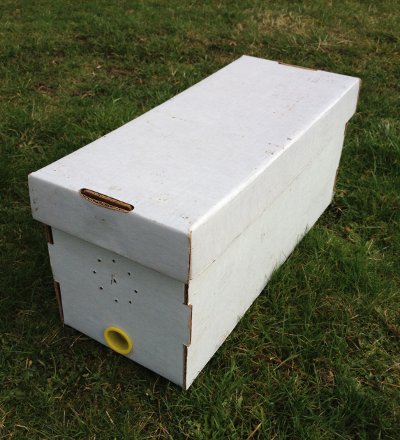Yep, it is just about that time of year that “free” bees are available. I use the term free loosely, because swarm capture will usually at least cost you some time and maybe some dollars. But don’t let that keep you from trying it. The first time I caught a swarm was really exciting. I called a friend who had caught swarms before to help me out. I’m still not sure that the first swarm was not from one of my own hives, but I do know the other two we found that day were not. Yes, that is right, three swarms at one time in the same area.
Before you go after that swarm
I recommend a few basic items in addition to your typical protective gear to capture your swarm:
- Bee brush
- Hive tools
- Box with a lid (a brood box or nuc box size)
- Garden clippers/ small garden hand saw (this assumes the bees are on some branch)
- Spray bottle with 1:1 sugar syrup
With these basic tools assuming the swarm is easy to reach, the process is pretty straight forward. Using a cardboard nuc box like that to the right I find works great. I have recovered several swarms without getting stung. Then there was the swarm I should have not attempted. It involved a tractor, night-time, and a little higher than I would have liked. In the end I got the swarm but also several stings.
What to do when you find the swarm
Swarms in our area are usually pretty gentle, especially since they are full of honey for their trip out to find a new home. Once you have your box and access to the swarm, all you need to do is move the swarm into the box. Often you will see swarm captures from a tree demonstrated by given the branch the swarm is on a quick jerk. This will dislodge the bees and drop them into the box. I do want to warn you that you will end up with a lot of bees flying around you. This could be unnerving the first time you do this and could be bad if you are at the top of a ladder or perched on a tree limb.
A simpler way is to simply cut the branch off if possible and lay it in the box gently. If the swarm is not on a branch you will probably need to gently “sweep” them off into your box with your bee brush. Once again be ready for some bees taking flight, but if done smoothly this should be a minimum. A few light sprays with your 1:1 syrup mix can also help calm them.
What about the stragglers
Do not be surprised if a few of these bees that take flight return to where the swarm was. There may even be a few stragglers hanging out where all of their sisters had been. A few stragglers is not much of a problem as long as you got the queen in the box. If time allows (I like over night when practical) just leave the box nearby in a safe place and let the bees fan the queens scent into the air. The fanning should attract the remaining bees into the box and you can take your colony to its new home.
Trust me though, there is nothing more frustrating than finding all the bees back in the same spot you just took them from. If you did not get the queen in the box, do not be surprised if this happens. Remember that day with three swarms I talked about. Well we did have to catch one of those swarms twice.
Bringing your swarm home to your Apiary
Hiving your newly caught swarm is much the same as installing a package into a new colony. Assuming there were not any frames in your box you transported them in, just pour the bees into their new home. I recommend feeding them, unless there is an abundance of nectar sources at the time. Feeding, I have found really seems to get the new colony off to a rapid build up. Since the queen is mixed in with the bees, the queen cage step associated with a package is not needed. It would be a good idea to check in a few days to see if the queen is laying and has a good brood pattern. Typically, it is the old queen that leaves the old hive with the swarm. Because of this you may need to re-queen your hive.
So what if you are not around during the day when the bees are swarming and you miss out. Don’t worry, there is another way. We will discuss this other way in our next post. Till then happy beekeeping.




